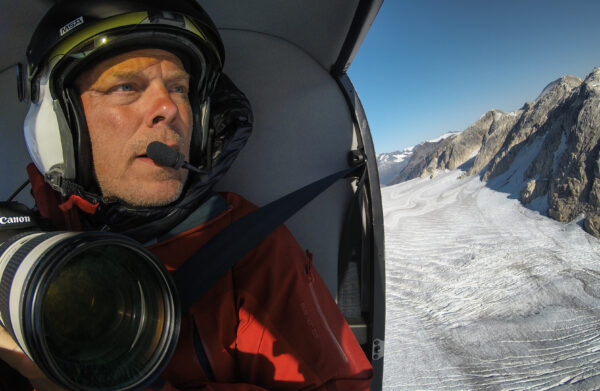
An Alaska-based writer and photographer who survived an avalanche near Eagle River nearly 40 years ago — a bone-crushing event that killed his best friend and climbing partner — has won Outside Magazine’s inaugural survival stories essay contest.
But Joe Yelverton says the real survival story isn’t about making it out of the mountains alive that day. It’s about digging himself out of the post-traumatic stress and grief that buried him for years, leading to addiction and thoughts of suicide, which almost killed him long after the snow had settled.
Still, Yelverton says the most formative moments of his life and the story of his survival began that day in 1984 with his friends Steve and Barry, as they approached the top of Eagle Peak.
Listen here:
[Sign up for Alaska Public Media’s daily newsletter to get our top stories delivered to your inbox.]
The following transcript has been lightly edited for clarity.
Joe Yelverton: I heard what sounded like an explosion. And Steve and I had been on this ledge that was kind of sticking out of the face. And it just sounded like thunder above us. And I looked up and saw about a probably 7- to 10-foot wave hit us. And then, of course, everything turned white. And below us was a series of small cliffs. And so we were being swept over some fairly steep terrain, consequently hitting the bottom of these cliffs and kind of getting rag-dolled through the rocks. And I just remember feeling a sense of weightlessness, and then, you know, crashing into the rocks as the avalanche was continuing down the mountain. There was one point where I came to a stop, so I was basically getting covered with avalanche debris at the bottom of a cliff. And I thought that was going to be the end of it right there, because I could feel the weight of all the avalanche debris piling on top of me. And then what happened was the avalanche just sympathetically triggered a bunch of other slopes. And so, thankfully, the slope that I was being buried on, it released. And so I ended up on top of the debris. I think Steve and I were probably carried down maybe 1,000 to 1,500 feet.
Casey Grove: And really badly injured, right? I mean, could you describe your injuries?
JY: Yeah, so I knew I was being pretty beat up in the avalanche. And I felt my leg bones snap. And it more or less felt like I was just being torn apart. So when I came to rest, I literally could just sit up. My legs were completely covered with snow. And so first thing I did was I cleared snow out of my mouth that had been packed so tightly in my mouth that I had to dig it out with my fingers, because I couldn’t breathe. And so I started looking around, and then that’s when I noticed Steve’s body was about 100 feet away from where I was. And I tried to yell for him and my voice wouldn’t work. And at that point, I tried to stand up and then my legs collapsed. So I tried to crawl over to him and I wasn’t able to even crawl. So I felt pretty helpless at that point.
I actually, to be honest, I wasn’t even sure if I was really alive. It was so surreal that I was was not really even sure if I had survived. I was really confused. I remember looking up where we had come from. And I saw a little figure, and that’s when I knew that Barry had survived. And it probably took him maybe 20 minutes or so to get down to me. He went to check on Steve first. But Steve had suffered some pretty severe injuries, and he was already dead at that point. So I think Barry just shifted his focus to trying to save me, and he really performed some superhuman feats. He literally carried my body off of the avalanche slope, down to a high pass, gave me all of his extra clothes, set me up so that I would have some food and water. And then he took off to go get help.
CG: I can’t even imagine what it was like to be waiting out there for that rescue to come. But, I mean, first of all, I just want to say, I’m sorry that that happened to you, and that it’s amazing you’re still here with us. And sorry about what happened to Steve, as well. What was it like waiting for that rescue and just the thoughts that were going through your head?
JY: Well, I honestly didn’t think I would ever see Barry again. You know, I was pretty sure that I wouldn’t survive. It wasn’t long that I started getting hypothermic. And I was passing in and out of consciousness. So to be honest, the time passed a lot faster than what you might think, because I was unconscious a lot of the time. But when I was awake, it was pretty tormenting because, you know, I could still see Steve just above me on the mountain. And I was starting to hallucinate. And I would wake up from what I thought was a dream, and I would see that his body was gone. And then I would start looking for him around me. And then I would gain consciousness, and I realized that I was having these hallucinations. So it was pretty disturbing. I was mainly focused on just trying to stay awake, knowing that my odds of surviving would be better if I tried to stay awake. And so eventually I heard a helicopter coming up the valley below me. I think I fell unconscious again. And I woke up to being dragged to the helicopter.
CG: Well, I guess maybe let’s try to take that next step and talk about how you were able to come to grips with this. And I understand it took quite a few years. what all did you go through to get to this point to be able to talk about it and write about it?
JY: So to make a long story short, I left Alaska, because I wanted to try and get away from my memories. And so I moved to Seattle, and I was down there working in the corporate world. And at that point, my flashbacks had morphed into much more violent episodes, involving explosions. I would see car bombs going off. Buildings exploding with me inside of them. And this was happening probably once a day, for years. And it was really anxiety and insomnia that drove me to go get counseling at the urging of my physician.
I started making some headway with a really great therapist, and I’ll never forget what she said to me. She said, “You know, you’re never going to get your old life back. This is your life. And your choice now is, what are you going to do with it?” It was really sobering. Because previous to that I felt like PTSD was whipping me around on the end of a long rope, and I had no control. And I started learning that I really was not my thoughts. She taught me techniques, basically meditation techniques, to just observe these flashback episodes, instead of reacting to them and cringing. She taught me just to kind of observe them, like standing on the edge of a river and just watching a piece of driftwood float down the river. And it proved to be incredibly effective. And so that was the beginning of me learning that dealing with this PTSD is really a lifelong process for me. It’s not, you know, there’s no Holy Grail of healing. It’s — I have to use discipline every single day. You know, I know to avoid triggers. I can’t watch violent movies. I’m very conscious of self care.
And so I started feeling better about about life, and I really started missing Alaska. So I moved back to Alaska, and it was really shortly after that, a little over 10 years ago, I met Roger Sparks, a former pararescueman, who had just finished his last deployment, a real violent deployment, and I met him at a potluck in Eagle River. And we became fast friends. I gained a window into his recovery. And I spent a lot of time with him. That eventually progressed into him doing tattooing on mostly military people, and many of whom also experienced trauma, and some of them PTSD. And so I would shoot these sessions, these tattoo sessions in his garage sometimes till 5 or 6 a.m., and I would gain insight into these people’s lives. A lot of different people, some special forces, pilots, that sort of thing, and was incredibly lucky to hear very profound things about their experience, not only, you know, in war, in deployment, but how traumatic civilian rescue was.
RELATED: Alaskan ‘Warrior’s Creed’ chronicles violence, rescues and how tattoos grounded him
So fast forward a few years, I got a grant to work on an environmental portrait of the rescue squad, and I spent a year with them, going on training missions with them, and just gaining a lot of insight into that very unique community. And we were coming back from a training mission through the Chugach Range, and one of the PJ’s was in the back, and he just sort of mentioned something about a rescue that he had been on, on this peak that we just just flew by. And he was kind of describing that — how stressful that rescue was. And within minutes, we were flying right by Eagle Peak. And, strangely, the mountains and helicopters are the only places I don’t ever have flashbacks. And so that was the only time I ever had a flashback in the helicopter. And I just sort of gritted my teeth, and I got through it. And we landed, and when I walked off the tarmac over at JBER, I grabbed all my gear and went to my truck, and I immediately started writing down some thoughts about that experience. And that was really the beginning of this essay. But still, Roger was the only person at this point who had insight into how bad my PTSD was. No one knew how bad it was. I just hadn’t shared that with anyone. And so that was incredibly powerful for me to spend time with these rescuers. Because, one, they trusted me. And I felt incredibly honored and grateful that they trusted me. But what I didn’t realize was it was a gift to me, because it allowed me to slowly come to terms with being OK with telling my story.
Read Joe Yelverton’s essay here.
Casey Grove is host of Alaska News Nightly, a general assignment reporter and an editor at Alaska Public Media. Reach him atcgrove@alaskapublic.org. Read more about Caseyhere.





